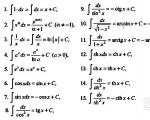The principle of operation of the generator presentation. Induction generator. Wide application of alternators
Regional State Autonomous Professional Educational Institution "Borisov Agro-Mechanical College"
- Presentation for a lesson on the topic; The design and principle of operation of a car generator.
- according to MDK 01 02 “Design, maintenance
- and car repair"
- Zdorovtsov Alexander Nikolaevich
- - a device that converts mechanical energy received from the engine into electrical energy. Together with the voltage regulator it is called generator set. Modern cars are equipped with alternating current generators.
- the output parameters of the generator must be such that the progressive discharge of the battery does not occur in any vehicle driving modes;
- the voltage in the vehicle's on-board network, powered by the generator, must be stable over a wide range of rotation speeds and loads.
- – serves to transmit mechanical energy from the engine to the generator shaft via a belt
- consists of two covers: the front (from the pulley side) and the rear (from the slip ring side), designed for fastening the stator, installing the generator on the engine and placing the rotor bearings (supports). On back cover a rectifier, brush assembly, voltage regulator (if built-in) and external terminals for connection to the electrical equipment system are placed;
- The rotor consists
- a steel shaft with two beak-shaped steel bushings located on it. Between them there is an excitation winding, the terminals of which are connected to slip rings. The generators are equipped primarily with cylindrical copper slip rings;
- 1. rotor shaft; 2. rotor poles; 3. field winding; 4. slip rings.
- Generator stator
- - a package made of steel sheets and shaped like a pipe. In its slots there is a three-phase winding in which the generator power is generated;
- 1. stator winding; 2. winding terminals; 3. magnetic circuit
- Assembly with rectifier diodes
- - combines six powerful diodes, three pressed into the positive and negative heat sinks;
- 1. power diodes; 2. additional diodes; 3. heat sink.
- - a device that maintains the voltage of the vehicle’s on-board network within specified limits when the electrical load, generator rotor speed and temperature change environment;
- – removable plastic design. It contains spring-loaded brushes that are in contact with the rotor rings;
- Contactless generator with excitation from permanent magnets.
- Alternator with beak rotor and slip rings
- Inductor alternating current generator.
- · a - generator model;
- · b- rotor with a permanent magnet NS and with six claw-shaped poles;
- · c - six-pole stator with three phase windings connected by a star;
- · NS - cylindrical permanent magnet with N and S poles;
- · M - stator magnetic circuit;
- · R- rotor magnetic circuit in the form of claw-shaped tips made of hard steel;
- · F - magnetic flux of the rotor;
- · 8- air gap;
- · F. - stator phase winding;
- · EF-EMF induced in the phase winding;
- · w - rotor rotational speed;
- · 1. 2, 3, total. - terminals of phase windings connected by a star.
- the rotating rotor is a permanent magnet, and the phase windings are coils on a stationary stator. Such a generator is called a non-contact alternating current generator with permanent magnet excitation. It can be single-phase or multidimensional. The generator is simple in design, reliable, not afraid of dirt, does not require electrical excitation, has no rubbing electrical contacts, and its service life is determined by the drying of the insulation of the phase windings. But in modern passenger cars, a generator with excitation from permanent magnets is not used due to the impossibility of strictly maintaining a constant operating voltage in it when the speed of the internal combustion engine changes.
- a - generator model; b - a dissected rotor with an excitation coil W„ and with six northern N and six southern S beak-shaped poles of a permanent electromagnet; c - simplified generator design;
- 1 - stator magnetic circuit M with phase windings Wph
- 2 - beak-shaped pole pieces of the rotor;
- 3 - excitation winding Wв;
- 4 - fan impeller;
- 5 - drive pulley;
- 6 - magnetic circuit R of the rotor;
- 7 - body covers;
- 8 - built-in rectifier;
- 9 - slip rings K;
- 10 - brush holder KShchM with brushes.
- Winding Wв with its terminals is connected to slip rings K, which in turn are connected through brushes KShchM to an external electrical excitation circuit. In this way, the beak-shaped rotor becomes a multi-pole permanent electromagnet, the magnetomotive force of which can be easily adjusted by changing the excitation current, which is very important for automobile electric generators.
- A generator with a beak-shaped rotor and slip rings is widely used in modern passenger cars.
- a - generator model;
- b - connection diagram of windings on a single-phase stator;
- c - simplified generator design;
- 1 - - rotor groove
- ;2 - bearing;
- 3 - rotor shaft;
- 4 - rotor pole
- ;5 - generator housing; Wв, Wф - excitation and phase windings.
- The main difference of this generator is that its rotating rotor is a passive soft magnetic ferromass, and the excitation winding is installed on a stationary stator along with the phase windings. To reduce magnetic losses, the rotor ferromass, like the stator, is made of a set of thin plates made of electrical steel. The generator is non-contact. The operation of such a generator is based on periodic interruption of the constant magnetic flux of the stator, which, when the rotor rotates, is achieved by periodically changing the size of the air gap between the stator and the rotor. Thus, the inductor generator is synchronous and is voltage controlled by changing the excitation current in the stator winding. The inductor generator implements the principle of producing EMF by changing the magnetic conductivity in the air gap: by controlling the magnitude of the stator magnetic field induction. By appropriately selecting the configuration of the surface of the passive rotor and the stator pole pieces, it is possible to bring the periodicity of magnetic flux changes closer to a sinusoidal law, which provides a sinusoidal shape to the operating voltage of the generator.
- http://respektt.ru/foto/generator_ustroistvo.jpg
- http://www.mlab.org.ua/articles/electric/59-electric-generator.html
- http://www.domashniehitrosti.ru/generator4.html
- Rodichev V. A.: Trucks. M.: Publishing center "Academy", 2010-239p.

The quantitative growth in the use of energy has led to a qualitative leap in its role in our country: a large branch of the national economy has been created - energy. Electric power industry occupies an important place in the national economy of our country. Nuclear power plant in France Cascade hydroelectric power station



If k > 1, then the transformer is step-up. If k 1, then the transformer is step-up. If k 1, then the transformer is step-up. If k 1, then the transformer is step-up. If k 1, then the transformer is step-up. If k title="If k > 1, then the transformer is step-up. If k


Problem: The transformation ratio of the transformer is 5. The number of turns in the primary coil is 1000, and the voltage in the secondary coil is 20 V. Determine the number of turns in the secondary coil and the voltage in the primary coil. Determine the type of transformer?

Given: Analysis: Solution: k = 5 n2 = 1000: 5 = 200 n1 = 1000 U1 = 20 V * 5 = U2 = 20 V n2 = n1: k = 100 V U1 = U2 * k n2 - ? U1 - ? Answer: n2 = 200; U1 = 100 V; step-up transformer, since k > 1. 1."> 1."> 1." title="Given: Analysis: Solution: k = 5 n2 = 1000: 5 = 200 n1 = 1000 U1 = 20 V * 5 = U2 = 20 V n2 = n1: k = 100 V U1 = U2 * k n2 - ? U1 - ? Answer: n2 = 200; U1 = 100 V;"> title="Given: Analysis: Solution: k = 5 n2 = 1000: 5 = 200 n1 = 1000 U1 = 20 V * 5 = U2 = 20 V n2 = n1: k = 100 V U1 = U2 * k n2 - ? U1 - ? Answer: n2 = 200; U1 = 100 V; step-up transformer, since k > 1."> !}
 13
13


Definition: Alternating current is called electricity, which periodically changes in magnitude and direction. Symbol or. Module maximum value current strength over a period is called the amplitude of current strength oscillations. Currently, electrical networks use alternating current. Many laws that were derived for direct current also apply to alternating current.

Alternating current has a number of advantages over direct current: - an alternating current generator is much simpler and cheaper than a direct current generator; - alternating current can be transformed; - alternating current is easily converted into direct current; - AC motors are much simpler and cheaper than DC motors; - the problem of transmitting electricity over long distances was solved only by using alternating current high voltage and transformers. To produce alternating current, a sinusoidal voltage is used.




An alternator is an electromechanical device that converts mechanical energy into alternating current electrical energy. Systems producing alternating current have been known in simple forms since the discovery of magnetic induction of electric current. The operating principle of the generator is based on the phenomenon of electromagnetic induction electrical voltage in the stator winding located in an alternating magnetic field. It is created using a rotating electromagnet of the rotor when direct current passes through its winding.






1 slide
Presentation on the topic: “Three-phase current generator” Municipal Atypical General Educational Institution “Gymnasium No. 1 of the city of Belovo” Head: Popova Irina Aleksandrovna Completed by: students of class 11 “B” Ponomarev Kirill Malakhov Alexander Glushchenko Anatoly Belovo 2011 BRAIN 2.0

2 slide

3 slide
Objectives: 1) understand the principle of operation of a three-phase generator 2) find out the advantages of three-phase systems 3) consider connections in three-phase circuits 4) compare phase (Uph) and linear (Ul) voltages 5) consider diagrams, graphs to study and consolidate knowledge of the topic. 6) carry out the experiment, applying the acquired knowledge 7) draw practical conclusions

4 slide
History of the origin... Mikhail O Sipovich Doli Vo-Dobrovolsky is a Russian electrical engineer of Polish origin, one of the creators of three-phase alternating current technology, a German entrepreneur. The creative and engineering activities of M. O. Dolivo-Dobrovolsky were aimed at solving problems that would inevitably be encountered with the widespread use of electricity. Work in this direction, based on the three-phase current obtained by Nikola Tesla, is unusually short term led to the development of a three-phase electrical system and a perfect design that, in principle, has not changed to this day asynchronous electric motor. Thus, currents with a phase difference of 120 degrees were obtained, a connected three-phase system was found, distinctive feature which was the use of only three wires for transmission and distribution of electricity.

5 slide
Design of a three-phase current generator The operating principle of the generator is based on the phenomenon of electromagnetic induction - the occurrence of electrical voltage in the stator winding located in an alternating magnetic field. It is created using a rotating electromagnet - the rotor - when direct current passes through its winding. Main elements: The inductor in a three-phase current generator is an electromagnet, the winding of which is powered by direct current. The inductor is the rotor, the generator armature is the stator. Three independent electrical circuits are located in the stator slots. windings shifted in space by 120 degrees. When the rotor rotates at angular speed, an induced emf occurs, changing. according to the harmonic law with frequency ω Due to the shift of the windings in space, the oscillation phases are shifted by 2p/3 and 4p/3.

6 slide

7 slide
Connections in three-phase circuits Phase voltage is the voltage between the beginning and end of each phase winding of the generator. Line voltage is the voltage between the beginnings of any two phase windings.

8 slide
Experiment Three coils with cores are placed around a circle at an angle of 120° with respect to each other. Each coil is connected to a galvanometer. A straight magnet is attached to the axis in the center of the circle. If you rotate the magnet, an alternating current appears in each of the three circuits. When the magnet rotates slowly, you can notice that the highest and lowest values of currents and their directions will be different at each moment in all three circuits.

Slide 9
Advantages of three-phase systems: 1) economical production and transmission of electricity 2) the ability to obtain a relatively simple circular rotating magnetic field 3) the ability to obtain two operating voltages in one installation: phase and linear 4) the use of fewer wires in production Conclusion: Thanks to these advantages, three-phase systems are the most common in modern power engineering.

10 slide
List of used literature: Bessonov L.A. Theoretical foundations of electrical engineering: Electric circuits. Textbook for students of electrical engineering, energy and instrument engineering specialties of universities. –7th ed., revised. and additional –M.: Higher. school, 1978. –528 p.; Glazunov A.T., Kabardin O.F., Malinin A.N., Orlov V.A., Pinsky A.A., S.I. Kabardina “Physics. Grade 11". – M.: Education, 2009. Fundamentals of circuit theory: Textbook. for universities / G.V. Zeveke, P.A. Ionkin, A.V. Netushil, S.V. Strakhov. –5th ed., revised. –M.: Energoatomizdat, 1989. -528 p.

"Electrical circuits of alternating current" - Application of electrical resonance. Vector diagram of voltages in an alternating current network. Ohm's law. Current fluctuations. AC electrical circuits. Electrical resonance. Diagram. Three types of resistance. Vector diagram. Diagram with only inductive reactance in the AC circuit.
"Alternating current" - Alternating current. Alternator. Alternating current is an electric current that changes over time in magnitude and direction. Definition. EZ 25.1 Producing alternating current by rotating a coil in a magnetic field.
““Alternating current” physics” - Capacitor resistance. Capacitor in an alternating current circuit. Current fluctuations on the capacitor. R,C,L in an AC circuit. How does a capacitor behave in an alternating current circuit? How does inductance behave? Let's analyze the formula for inductive reactance. Using the frequency properties of a capacitor and inductor.
“Resistance in an alternating current circuit” - Inductive reactance is a quantity characterizing the resistance provided to alternating current by the inductance of the circuit. Capacitance is a value that characterizes the resistance provided to alternating current by electrical capacitance. Are the shapes the same color? Active resistance in an alternating current circuit.
“Alternating electric current” - Let us consider the processes occurring in a conductor connected to an alternating current circuit. Active resistance. Im= Um / R. i=Im cos ?t. Free electromagnetic oscillations in the circuit quickly fade and are therefore practically not used. Conversely, undamped forced oscillations are of great practical importance.
“Transformer” - If the answer is “yes”, then to what current source should the coil be connected and why? Write a summary for paragraph 35 Physical processes in a transformer. Task 2. AC power supply. Induction emf. K – transformation coefficient. Write the formula. Is it possible to convert a step-up transformer into a step-down transformer?




